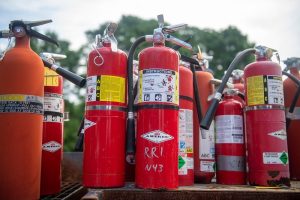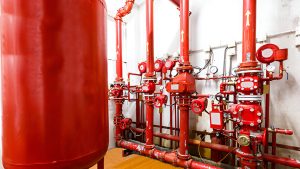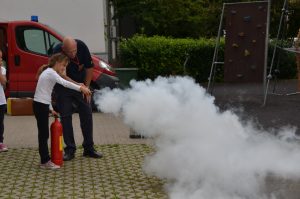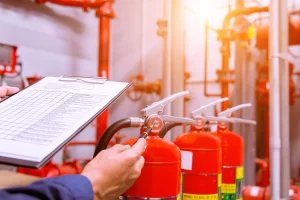Introduction
Fire safety is a critical aspect of home and workplace safety that often goes overlooked until it’s too late. One of the most vital tools for combating small fires is the fire extinguisher. Despite their presence in many homes and businesses, few people understand how to use them properly. This comprehensive guide will not only walk you through the steps of using a fire extinguisher but also delve into the different types of extinguishers and their appropriate applications. Equipped with this knowledge, you could potentially save lives and property in the event of a fire.
Understanding Fire Extinguishers
Fire extinguishers are categorized into different classes based on the type of fire they are designed to combat. Each class is indicated by a letter and sometimes a numerical rating that signifies its effectiveness.
Class A: Ordinary Combustibles
Class A fire extinguishers are used for fires involving ordinary combustibles such as wood, paper, cloth, rubber, and some plastics. These extinguishers typically use water or a foam agent to cool the fire and remove the heat.
- Common Agents: Water, Foam
- Applications: Homes, offices, schools
Class B: Flammable Liquids and Gases
Class B fire extinguishers are designed for fires involving flammable liquids such as gasoline, oil, paint, and solvents. They also cover flammable gases like propane and butane. These extinguishers work by creating a barrier between the fuel and the oxygen or by inhibiting the chemical reaction.
- Common Agents: Foam, Carbon Dioxide (CO2), Dry Chemical
- Applications: Gas stations, kitchens, laboratories
Class C: Electrical Fires
Class C fire extinguishers are intended for fires involving electrical equipment. Water-based extinguishers should never be used on electrical fires due to the risk of electrical shock. Instead, these extinguishers use non-conductive agents to put out the fire.
- Common Agents: Carbon Dioxide (CO2), Dry Chemical
- Applications: Offices, data centers, homes
Class D: Combustible Metals
Class D fire extinguishers are used for fires involving combustible metals such as magnesium, titanium, potassium, and sodium. These are typically found in industrial settings. The extinguishing agents used for these fires work by absorbing heat and forming a crust that separates the metal from the oxygen.
- Common Agents: Dry Powder
- Applications: Manufacturing plants, laboratories
Class K: Kitchen Fires
Class K fire extinguishers are specifically designed for kitchen fires involving cooking oils and fats. These extinguishers use a wet chemical agent that cools the fire and forms a soapy foam blanket to prevent re-ignition.
- Common Agents: Wet Chemical
- Applications: Commercial kitchens, restaurants
Choosing the Right Fire Extinguisher
Selecting the appropriate fire extinguisher for your home or workplace involves understanding the potential fire hazards present and matching them with the correct class of extinguisher.
- Identify Potential Fire Hazards: Assess the environment to determine the types of fires that could occur.
- Check Extinguisher Ratings: Look for the labels on extinguishers indicating their class and effectiveness.
- Ensure Accessibility: Place extinguishers in easily accessible locations and ensure they are unobstructed.
Ensuring Your Fire Extinguisher is Ready
Before attempting to use a fire extinguisher, it’s crucial to ensure it is in working condition. Here are the steps to take:
- Check the Pressure Gauge: Fire extinguishers have a pressure gauge with a needle that should be in the green zone, indicating it is fully charged and ready for use.
- Inspect for Damage: Look for any signs of damage or corrosion that might prevent the extinguisher from working properly.
- Ensure the Safety Pin is Intact: The safety pin should be in place to prevent accidental discharge.
When to Use a Fire Extinguisher
It’s essential to know when it is safe to use a fire extinguisher and when it is best to evacuate and call emergency services. Follow these guidelines:
- Assess the Fire Size: If the fire is small and contained, it can be safely tackled with a fire extinguisher. If it is larger than a wastepaper basket, evacuate immediately.
- Check Your Escape Route: Always ensure you have a clear path to exit if the fire becomes uncontrollable.
- Call Emergency Services: Even if you believe you can control the fire, it’s wise to call 911 or your local emergency number as a precaution.
Using the PASS Technique
The PASS technique is a simple method to remember the steps for using a fire extinguisher effectively:
- Pull the Pin: This unlocks the operating lever and allows you to discharge the extinguisher.
- Aim Low: Point the nozzle or hose at the base of the fire to tackle the source of the flames.
- Squeeze the Lever: This releases the extinguishing agent. Maintain steady pressure for a continuous discharge.
- Sweep Side to Side: Move the nozzle from side to side, covering the base of the fire until it is completely extinguished.
Detailed Steps for Using a Fire Extinguisher
Step 1: Pull the Pin
The pin is a safety mechanism to prevent accidental discharge. Firmly grasp the ring and pull it out from the handle. This will break the tamper seal and make the extinguisher ready for use.
Step 2: Aim the Nozzle
Aim the nozzle or hose at the base of the fire. It’s crucial to target the fuel source rather than the flames to effectively extinguish the fire.
Step 3: Squeeze the Lever
Apply steady pressure to the lever to release the extinguishing agent. Be prepared for a forceful discharge and maintain control of the extinguisher.
Step 4: Sweep Side to Side
Sweep the nozzle from side to side at the base of the fire. Continue until the fire is completely out. Keep an eye on the area for re-ignition and be ready to repeat the process if necessary.
Training and Preparedness
Proper training and preparedness are key to effectively using a fire extinguisher. Here are some tips to ensure you are ready:
- Fire Extinguisher Training: Participate in fire extinguisher training sessions offered by local fire departments or safety organizations. These sessions provide hands-on experience and enhance your confidence in using the equipment.
- Regular Drills: Conduct regular fire drills in your home or workplace to ensure everyone knows the evacuation routes and how to use the extinguishers.
- Educational Resources: Utilize online resources and instructional videos to reinforce your knowledge. The National Fire Protection Association (NFPA) offers valuable information on fire safety here.
Recommended Videos
Watching instructional videos can be an excellent way to understand how to use a fire extinguisher. Here are some recommended videos:
- How to Use a Fire Extinguisher – Fire Safety Training Video – This video provides a comprehensive demonstration of the PASS technique.
- Fire Extinguisher Training Video – PASS Method – Another detailed guide on using a fire extinguisher effectively.
- Understanding Fire Extinguishers – Types and Uses – This video explains the different types of fire extinguishers and their applications.
Maintenance and Inspection
Regular maintenance and inspection of fire extinguishers are essential to ensure they function correctly during an emergency. Follow these guidelines:
- Monthly Inspections: Conduct a visual inspection of each extinguisher every month. Check for visible damage, ensure the pressure gauge is in the green zone, and verify that the safety pin is intact.
- Annual Professional Inspections: Have a qualified technician inspect and service your extinguishers annually. They will check the internal components, recharge if necessary, and ensure the extinguisher is in optimal condition.
- Replace or Recharge Used Extinguishers: After using an extinguisher, even if only partially, it must be recharged or replaced. Contact a certified fire extinguisher service provider to handle this process.
Conclusion
Knowing how to use a fire extinguisher is a crucial skill that can save lives and property. By understanding the different types of fire extinguishers, selecting the right one for your environment, and practicing the PASS technique, you can be prepared to respond effectively to a fire emergency. Regular maintenance and training further ensure that you are ready to act swiftly and safely. For more information on fire safety, visit the National Fire Protection Association (NFPA) here or watch the recommended instructional videos. Stay safe and be prepared!

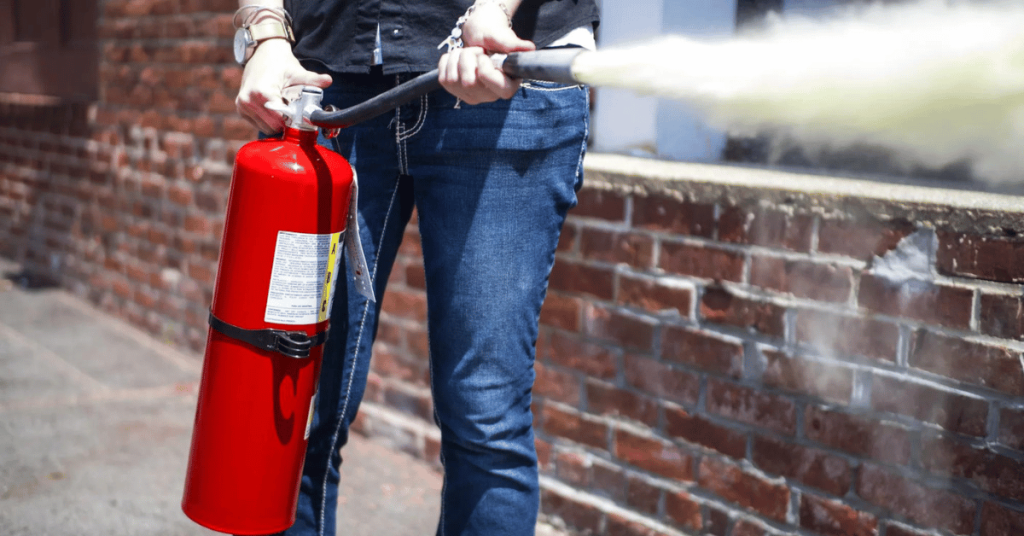

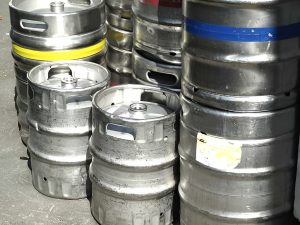
![[GetPaidStock.com]-6798ba4e6200e](https://servicedfireequipment.com/wp-content/uploads/2025/01/GetPaidStock.com-6798ba4e6200e-300x182.jpg)
